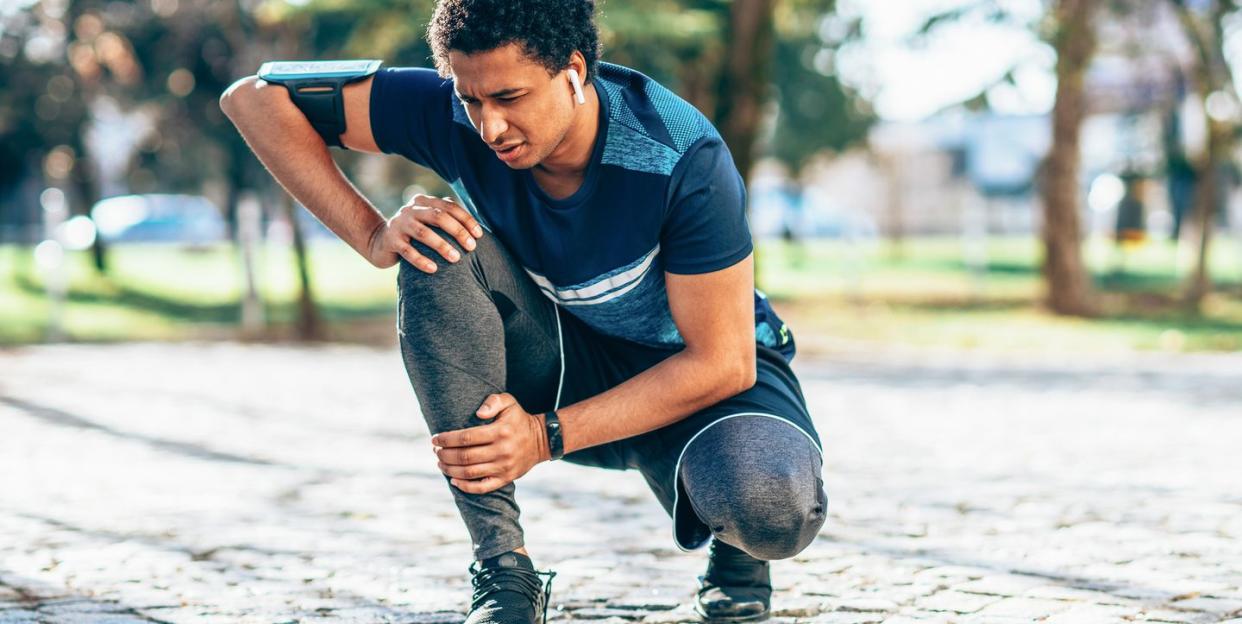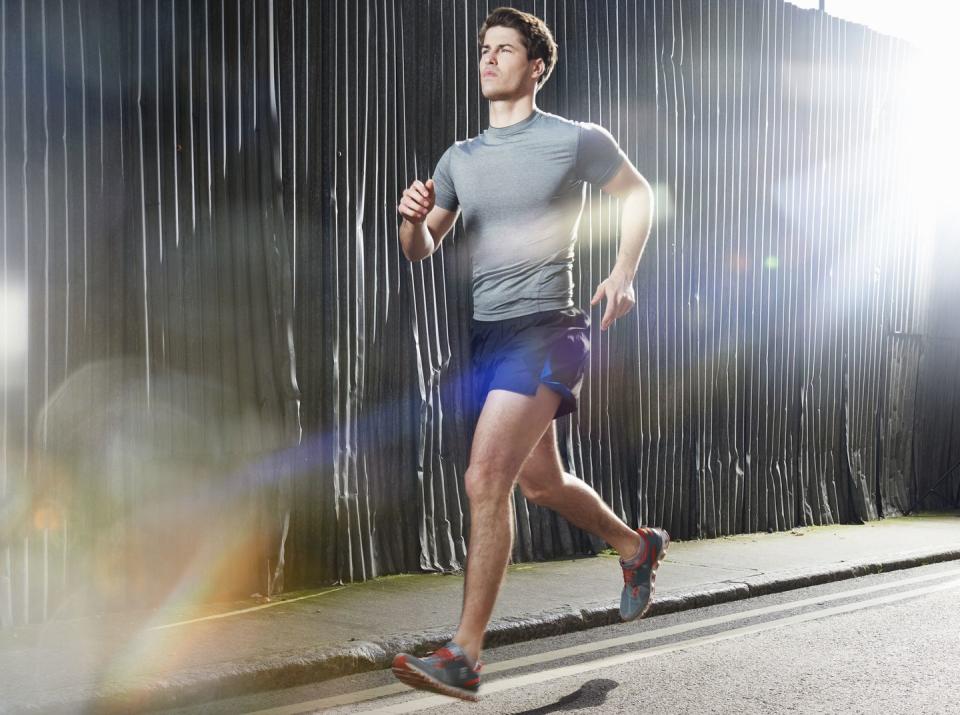The Best Ways to Treat and Prevent Shin Splints, According to Physical Therapists

"Hearst Magazines and Yahoo may earn commission or revenue on some items through the links below."
RUNNING IS ONE of the simplest ways to get a workout. You just lace up your shoes, head out the door, and get moving. But there's more to a healthy running habit than just jogging down the road, especially if you wind up with an overuse injury like shin splints.
If you’ve ever experienced this painful malady before, you know all too well what a bummer it can be—your fun run routine shifts to a painful trudge, and eventually, the pain in your lower legs can become too much to handle without treatment. This can be a killer for your fitness goals, especially if you're just getting started with consistent training or you're ramping up mileage and volume for a race.
You should understand exactly what's going on with your lower legs if you start to experience pain and discomfort when you run.
What Are Shin Splints?
To start, there's an important distinction to make in regard to how people understand what shin splints are and the injuries PTs wind up treating. "Technically, shin splints can refer to a stress fracture in your tibia bone in your lower leg," says Bespoke Treatments physical therapist Daniel Giordano, DPT, C.S.C.S. "If you're experiencing deep pain in your lower leg, I highly recommend that you contact a physician and get that assessed." But that's not always what people are referring to when they talk about shin splints. "The more common understanding of shin splints is actually tension in your lower leg in the tibialis anterior muscle or even in the calf muscle that can cause tension from the back to the front of your lower leg," he continues.
The painful condition can be caused by micro tears that form along the border of the tibia and the lower leg muscles, where they attach to the bone. "Shin splints (also known as Medial Tibial Stress Syndrome) is a painful syndrome that is often the results of a 'too much too soon' approach to training (in other words, overloading)," says Dr. Rachel Tavel, PT, DPT, CSCS, physical therapist at Shift Wellness in NYC.
"It can feel like a dull ache in the lower leg, along the bottom third of the leg, or like a hammer is pounding at the bone when you walk or run," Tavel continues. "There is usually some tension/tightness around the area as well."
But don't worry if you're feeling the pain—the condition is also super common and normal.
"Shin splints are very common in the U.S., with more than 3 million cases reported a year," says Dr. Mirette Mikhail, PT, DPT, CEIS, MTC, CertDN, and clinic director at ATI Physical Therapy.
How To Prevent Shin Splints

If you frequently get shin splints, that may be an indicator of muscle weakness in other parts of your body.
"While shin splints is a common lower leg injury, it is imperative that runners improve hip and core strength simultaneously," says Dr. Anh Bui, PT, DPT, C.S.C.S., a physical therapist at EXOS in Larkspur, California. "The glutes, in particular, are the largest, most powerful muscle in the human body and influence control of the knee and ankle joints, which can minimize stress on smaller muscles in the lower leg."
And while stretching and strengthening is crucial, improving running mechanics is just as important. "Overstriding is the number one risk factor during running associated with shin splints." says Dr. Bui. "Landing with your foot far in front of your body increases the impact forces going directly to the tibia (shin bone) instead of being absorbed by larger joints such as the hip. Runners with shin splints should look at their cadence (step rate per minute) and increase by 5 to 10 percent if cadence is less than 180."
However, the key to preventing shin splints is to address the problem as soon as you start to feel it. "Once pain starts, a patient should rest the area, apply ice and then massage," says says Dr. Mikhail. "Consider modifying your sport as running or jumping tends to cause shin splint pain."
You should also reconsider your shoe selection. "Proper shoe wear is also important as sometimes a loss of arch support is the cause of shin splints," adds Dr. Mikhail.
Again, if your shin splints are not going away or you experience intense pain, you may need to see a doctor. "You should be referred to a MD to ensure the cause of pain is in fact shin splints and not something more serious, like anterior compartment syndrome," notes Dr. Mikhail.
If it's too late and you're not able to prevent the condition, you do have options. One of the best ways to get rid of shin splints is to stretch out.
Who Can Benefit From Shin Splints Stretches?
If you're a runner, says Giordano, shin splints may be common, especially if you're a beginner runner and you increase your volume or intensity too fast.
But even experienced athletes can struggle with shin splints, too. "If you're an advanced runner or an expert runner this can also happen to you," he continues. "For example, if you are in marathon training or you're in marathon season, increasing your volume to a certain point can actually just put a lot of stress on the muscles of your lower leg."
In other words, runners who are introducing more volume to their routines, whether they're just starting out or experienced racers, can wind up with shin splints. So if you're in one of those categories, you can benefit from a stretching protocol.
4 Shin Splints Stretches to Relieve Tension
Ahead, four stretches to help decrease tension in your lower legs and help alleviate those shin splints.
Foam Rolling the Shins
The first exercise is foam rolling the shins, so you’ll need a foam roller for this move. While doing this move, make sure you’re covering the whole muscle from your knee down to the ankle joint.
How to Do It:
Get on the ground, face down, and place the front of your lower leg on the foam roller.
Once the lower leg is in position on the foam roller, slightly rotate the foot inwards. This is to “really get the anterior or tibialis anterior muscle that runs in the front part of the shin,” says Giordano.
Lightly roll up your leg up and down the foam roller. As Giordano comments, what we're trying to do here is to increase the pliability of the soft tissue, or essentially soften the muscle in your lower leg. “If it's too intense, what we can do is actually just ease the body weight or body weight compression on the foam roller and just come down and bring this knee down to the ground a little bit,” says Giordano. “So it's going to lessen the intensity of the foam roller and then just go back and forth.”
For a pre-warm-up or for a post-activity move, do 45 seconds of foam rolling to increase the softness of the tissue and increase the blood flow to the area. This can help decrease the tension on your shins.
3-Directional Ankle Mobility
Onto the next move for shin splints, a multidirectional exercise that focuses on increasing movement in your ankle.
How to Do It:
Come into the half-kneeling position and place both your hands on the upright knee.
For the first direction, move your knee forward over the big toe. Move it back and move the knee forward over the middle toe. Move it back, and then move the knee forward over the outside of the foot. “What we're trying to do is increase the range of motion of the ankle, which will help take some pressure off of the shins.
Do 10 to 15 of these in all directions either before or after you work out to try to get that range of motion of that ankle to improve and decrease tension in that lower leg.
Tibialis Anterior Stretch
The next stretch is a tibialis anterior stretch or a stretch of the anterior part of your shins.
How to Do It:
Come down onto your knees on the floor as you bring your toes together behind you with your knees wide. Walk your butt back towards your heels.
Once you’re deep into this position, slightly lift one knee up, creating a stretch right to the anterior part of that shin, and then come down and switching sides
As a warmup, hold these for about three seconds and perform 10 to 15 reps. As a cooldown or post-activity move do three sets of about 30-second holds. This can "decrease tension in the muscle, improve your flexibility and improve or decrease your soreness before your next workout," says Giordano.
Runner Stretch
Last but not least we have this popular runner stretch.
How to Do It:
Standing up, get into a lunge position, bending your front knee and grounding your back heel into the ground.
Lean your weight forward, which will create a stretch through that back side of your leg or into that calf muscle. As Giordano highlights, it’s extremely important that we stretch the posterior aspect of our lower legs because sometimes the tension in our lower legs can lead to tension in the front.
If you’re opting for this move as a pre-warm-up stretch, hold for three seconds, come back up and repeat. Post-workout or run, do three sets of 30-second holds at the bottom and then come back up.
For your own safety, it bears repeating: if you’re experiencing deep pain or extreme pain, see a doctor. “But if it's more just muscle tension, perform these exercises before or after activity in order to improve performance or decrease your soreness before your next workout,” says Giordano.
You Might Also Like

